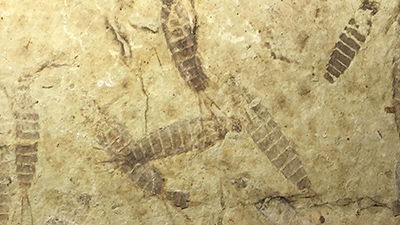
Ancient Tropical “Transitional” Forests Found Fossilized in the Arctic
The discovery of ancient trees fossilized in what looks like a forest is always big news. However, when they are believed to have been tropical trees and they are uncovered in what is now the Arctic, it is even bigger news.
According to articles in Science Daily and Geology, Chris Berry, of the School of Earth and Ocean Science at Cardiff University, and John Marshall, of National Oceanography Centre, University of Southampton, have identified a number of “fossil forests” on the island of Spitsbergen in the Svalbard archipelago in the Arctic Ocean north of Norway.1
The trees making up these claimed fossil forests are lycopsids. Such trees are not found alive today, but living relatives in the same class are the clubmosses. Twenty-six stems of these fossil lycopsids were found in three locations as vertical external molds and upright internal casts some 2–4 inches (55–95 mm) wide in dense strands spaced about 6–8 inches (~15–20 cm) apart. Whereas these upright fossil stems were found buried in a sandstone layer, their bases extended down into the underlying mudstone, which contains what have been interpreted as sub-horizontal roots.
An Evolutionary Interpretation
These scientists have made several claims about these fossil trees based on their evolutionary interpretation of the geologic record, which they believe accumulated over millions of years. Based on the relative position of the host sandstone in the strata sequence and the fossil pollens and spores contained in the underlying mudstone, these fossil trees were dated as “late Middle Devonian” or 380 million years old.2
This makes them supposedly transitional in the process of colonization of the land. After all, these scientists believe that as the strata slowly accumulated over millions of years, different plants and animals lived, died, and were buried and fossilized. Thus the sequence of plants found in the fossil record represents the order of their evolutionary development. In strata below the Devonian, there are mainly shallow water marine fossils; whereas in the Devonian and above, the strata start to also contain evidence of land plants, like these lycopsids. Within evolutionary thinking then, these lycopsids are claimed to have been among those plants that had started to evolve the ability to grow in soils and thus “conquer” the land, making them transitional. After all, the mudstone is interpreted to have been the soil, now also fossilized, in which these lycopsids grew.

A lycopsid presumed to have been fossilized in situ at Joggins in Nova Scotia. To see the images of the lycopsid fossils and microscopy from the Svalbard study, see the LiveScience compilation page. Nova Scotia photograph credits: Michael C. Rygel via Wikimedia Commons.
It is interesting though that the authors of this research report suggest that these sediments were conglomerates, which accumulated in an “alluvial fan,” perhaps an admission that this sediment really was not a soil, but instead deposition had to be rapid enough to bury these tree stems quickly before they could rot!3 This is not dishonesty, just the result of their worldview bias that misses details which don’t seem important to their interpretation of the data.
Furthermore, these lycopsids are claimed to have been tropical plants. This is based on where the island of Spitsbergen was situated in the past when the continents evidently were in different positions. According to the conventional “paleogeographic” reconstruction and “paleoclimatological” interpretation of Scotese, Boucot, and Chen, Spitsbergen in the Devonian was in the paleoequatorial zone and thus tropical, so the lycopsids must have been tropical plants.4 Since then, Spitsbergen has drifted northwards (supposedly slowly as per conventional theory) to its current Arctic location.
Was Weathering a Factor?
Putting together the pieces in their puzzle, Berry and Marshall claim that this high-tree density tropical vegetation may have promoted rapid weathering of soils, and hence enhanced carbon dioxide drawdown. In a press release, these authors claimed that these lycopsids must have had powerful carbon-dioxide-absorbing abilities because “the discovery of these strange forests could finally explain a drastic drop in atmospheric carbon dioxide during the late Devonian period,” by as much as a fifteenfold reduction.5
So what are we to make of all these claims, and what lessons can we learn? We have to be discerning when we read such news stories, to separate what is actual observational fact from what is evolutionary interpretation.
To begin with, it is true that the authors were not researching paleoclimate change, because the objective in their research report was to describe and interpret the fossils they found. So most of their paper reports the methods they used, the results of what they found, and discussion of the broader implication of their results. Because there has been a long-standing evolutionary claim of a fifteenfold reduction of atmospheric carbon dioxide during the Devonian, and that this is likely due to the rise of tree-sized plants which can lock up much larger amounts of carbon than can small herbs composed of nearly leafless stems, the authors claim they have found evidence of the plants that could have done that. But where are the data in the paper from which it can be concluded that these lycopsids had powerful carbon-dioxide-absorbing abilities that could have drastically reduced the atmospheric carbon dioxide by as much as fifteenfold? They merely cite earlier authors who provide evidence of atmospheric carbon dioxide drawdown. These lycopsids are extinct so their carbon-dioxide-absorbing abilities cannot be measured today. So how can past atmospheric conditions and weathering of soils be inferred from these fossils? True, there are extant varieties of lycopsids today, albeit very much smaller than these fossil lycopsid trees, that have been noted for their unusual metabolic strategy for uptake and storage of carbon.6 However, it does not necessarily follow that just because today’s diminutive lycopsids have a high carbon uptake ability that these very much larger fossil lycopsids trees had the same ability to the same degree. The present is not the key to the past, but rather, what happened in the past to bury these lycopsids explains the fossils in the present.
The present is not the key to the past, but rather, what happened in the past to bury these lycopsids explains the fossils in the present.
Thus this fossil-bearing sedimentary rock sequence on Spitsbergen is better understood from the biblical perspective of the eyewitness account in Genesis to be part of the geologic record of the Flood—the “billions of dead things buried in rock layers laid down by water all over the earth” (Genesis 6–9). Thus these fossil lycopsids are not 380 million years old but only about 4,350 years old, the approximate date for the year of the Flood. They were pre-Flood plants swept away by the waters of the Flood and buried in these sedimentary layers.
What’s Not Included
Why then were they buried vertically if they did not grow where they are now found buried? Surely the roots found in the mudstone prove these lycopsids grew in place. Actually no! There is no indication in the technical paper by Berry and Marshall that they found the roots connected to the lycopsids’ trunks. Indeed, they did not describe or provide photographs of these claimed roots and did not claim they were attached to the lycopsids’ trunks. They were just in the mudstone interpreted as a paleosol below the lycopsids trunks. Yet the authors did not provide the criteria by which they identified them as roots. Even though other experts could easily check such an identification, the readers of their paper simply cannot be sure that they are indeed roots.
The authors state that “stratification of the underlying horizons demonstrates limited vertical root penetration and bioturbation.”7 But could those “roots” simply be bioturbation? Without identification criteria provided we cannot know, because the authors do not adequately describe these features. Even the experts can disagree where so much subjectivity can be involved. In any case, for the incredible abundance of upright stems they described, there appear to be very few roots. This seems rather odd, especially if these “forests” were buried rapidly. Why did the trunks get preserved but not the roots? In modern forests, roots are often more durable than the trunks, although we do not know for sure that this is true with the plants being described here because they are extinct. Perhaps like their modern counterparts, the roots of these plants were more like tubular leaves, which are not woody and therefore may not have persisted for long. They merely assumed these “roots” belonged to the lycopsids and identified the mudstone as a “fossil soil” (or paleosol) based on referencing paleosol expert Greg Retallack. But even he identifies paleosols on the basis of the slow-and-gradual burial belief system by which evolutionists interpret most of what they see in the rock record.
The authors also do not provide any criteria for identification of the “paleosol” other than that it is a mudstone and that it contains “roots,” and then citing paleosol expert Retallack. However, the authors generally describe the lycopsid trunks as being buried in sandstone beds. Their published stratigraphic column indicates they are coarse sandstones, and they mention that the sandstone units contain pebble-sized clasts and sometimes have basal conglomerates. Then later they admit the lycopsid trunks were actually buried in conglomerate. This is significant because coarse sandstones with pebble-sized clasts and conglomerates require fast-moving bodies of water for their deposition. Furthermore, the fact that the bases of the lycopsid trunks are embedded within the underlying mudstone does not mitigate against their rapid burial, as mudstones have also been demonstrated experimentally to be rapidly deposited.8 These “forests” are thus unusual in that they are buried in conglomerate, which is similar to the claimed “fossil forests” on Specimen Ridge in Yellowstone National Park. Indeed, similar lack of providing enough observational data at Specimen Ridge to draw conclusions from also led to the wrong conclusions there.
There is . . . an excellent modern observed analog for the rapid vertical burial of these lycopsid trunks.
There is, in fact, an excellent modern observed analog for the rapid vertical burial of these lycopsid trunks, consistent with their lack of attached roots. Since the modern counterparts of these fossil lycopsids have swollen bulbous bases with “roots” coming directly off them, these fossil lycopsids may have been well structured to sink upright in water. In Spirit Lake at Mount St. Helens after the May 18, 1980, eruption, floating logs, with their roots snapped off by the volcanic blast that sheared the tree trunks off, became waterlogged, sank, and were buried vertically in the accumulating sediments on the lake bottom.9 This analog has been very successfully used to explain the Specimen Ridge “fossil forests” because exactly the same features of trunks with roots snapped off buried in rapidly deposited sediments are seen there. So these lycopsids do not represent “fossil forests.”
Cause and Effect
And as for the order of fossils in the geologic record, this is just the burial order of different creatures and plants during the Flood.10 The Bible says that the Flood began with the breaking up of all the fountains of the great deep, so this implies that the Flood began in the pre-Flood ocean basins. The earth movements involved as the ocean floor was ruptured would have produced tsunamis that swept across the ocean toward the land. Near the coast, these tsunamis would have scoured the shallow ocean floor, picking up the shallow water marine creatures and carrying them with sediments to be buried by the sediment-laden surges of ocean waters up onto the land. If these lycopsids were part of floating forests growing on the ocean’s surface near the coastline, then these forests would have been next to be broken up and swept away as the ocean waters surged landwards and buried these lycopsids in sediments. Only subsequently would land plants start to get buried by further sedimentation on top of the earlier deposited sediment layers that contain only shallow-water marine creatures and then these lycopsids. These plants were not transitional colonizers of the land but were simply buried a few weeks after the initial deposition of only shallow-water marine creatures during the early stages of the Flood.
Now it is possible that Spitsbergen was at an equatorial latitude at the time these lycopsids were buried during the Flood year. Before the Flood it seems likely that there may have been one supercontinent, because Genesis 1:9–10 says God gathered the waters into one place to make the dry land, which may likewise have been in one place. Then the rupturing of the ocean floor, resulting from the breaking up of the fountains of the great deep, may have also split that supercontinent apart. The continental fragments may then have rapidly moved across the globe in a process called catastrophic plate tectonics to eventually become today’s continents in their current positions.11 Thus Spitsbergen containing these fossil lycopsids may well have moved through equatorial latitudes during the Flood on its catastrophic journey from its pre-Flood position on the globe to its present Arctic location.
There definitely were vast movements in the carbon cycle during the Flood.
As for the fifteenfold reduction of carbon dioxide in the atmosphere, that is merely an artificial consequence of the scientists’ evolutionary interpretation of the carbon content of Devonian and Carboniferous sedimentary rocks compared with that in Cambrian to Silurian sedimentary rocks, and their observation that these fossil lycopsids might be “good” candidates for causing that reduction. Flood geologists would instead interpret the different carbon contents in those sedimentary rocks as simply the carbon which was buried in those different layers only weeks apart during the Flood. If these lycopsids did not grow where they are found buried, then they were not drawing down carbon dioxide from the atmosphere at the time they were being buried. That is not to say these and other plants did not draw down carbon dioxide from the pre-Flood atmosphere, as undoubtedly they did. Indeed, there may have been a higher carbon dioxide content in the atmosphere prior to the Flood that improved plant growth. And carbon dioxide may have been added to the atmosphere by all the catastrophic volcanic activity that erupted many thick extensive lava flows during the Flood. There definitely were vast movements in the carbon cycle during the Flood as enormous quantities of plants and creatures were buried, massive volcanoes erupted, and lime precipitated from the waters of the Flood to help produce vast quantities of limestone. In the decades after the Flood, this would have resulted in the climate instability that caused the subsequent Ice Age.
There is however an ironic twist to the carbon dioxide “story.” If there were fifteen times more carbon dioxide in the earth’s atmosphere in the past, then it was good for vigorous plant growth. Furthermore, in the evolutionary view, this was before man arrived on the scene to burn wood and coal, and to drive cars and trucks. In other words, man had no control over the drastic past climate changes claimed by these scientists. There is a lesson here though, and that is man had no control over what happened during the Flood and thus also the climate after the Flood, all of which was under God’s sovereign control as He judged the pre-Flood human population because of their wickedness. Similarly, man has no control over the present and future climate, which are also under God’s continuing sovereign control. And just as surely as God has judged the whole world the last time by water, He has warned us that the next time He will judge the globe by fire (2 Peter 3:5–7).
Footnotes
- Cardiff University, “Ancient Fossil Forest Unearthed in Arctic Norway,” Science Daily, November 19, 2015, http://www.sciencedaily.com/releases/2015/11/151119103544.htm; C. M. Berry and J. E. A. Marshall, “Lycopsid Forests in the Early Late Devonian Paleoequatorial Zone of Svalbard,” Geology 43, no. 12 (2015): 1043–1046, doi: 10.1130/G37000.1.
- C. M. Berry and J. E. A. Marshall, “Lycopsid Forests in the Early Late Devonian Paleoequatorial Zone of Svalbard,” 1043.
- Ibid., 1045.
- C. R. Scotese, A. J. Boucot, and X. Chen, http://www.scotese.com/mdevclim.htm.
- Alyssa Danigelis, “Ancient Forests Discovered in the Arctic,” Discovery News, November 19, 2015, http://news.discovery.com/earth/ancient-fossil-forests-discovered-in-the-arctic-151119.htm.
- W.A. Green, “The Function of the Aerenchyma in Aborescent Lycopsids: Evidence of an Unfamiliar Metabolic Strategy,” Proceedings of the Royal Society B 277 (2010): 2257–2267, doi: 10.1098/rspb.2010.0224.
- C. M. Berry and J. E. A. Marshall, “Lycopsid Forests in the Early Late Devonian Paleoequatorial Zone of Svalbard,” 1045.
- Joe H.S. Macquaker and Kevin M. Bohacs, “On the Accumulation of Mud,” Science, no. 318, December 14, 2007: 1734–1735, doi: 10.1126/science.1151980; Juergen Scheiber, John Southard, and Kevin Thaisen, “Accretion of Mudstone Beds from Migrating Floccule Ripples,” Science, no. 318, December 14, 2007: 1760–1763, doi: 10.1126/science.1147001.
- Andrew A. Snelling, Joe Francis, Tom Hennigan, “Lasting Lessons from Mount St. Helens,” Answers, April–June 2015, 56–66.
- Andrew A. Snellling, “Order in the Fossil Record,” Answers, January–March 2010, 64–68.
- Andrew A. Snelling, “A Catastrophic Breakup: A Scientific Look at Catastrophic Plate Tectonics,” Answers, January–March 2007: 44–48, https://answersingenesis.org/geology/plate-tectonics/a-catastrophic-breakup/; “Noah’s Lost World,” Answers, April–June 2014, 80–84, https://answersingenesis.org/geology/plate-tectonics/noahs-lost-world/.
Recommended Resources

Answers in Genesis is an apologetics ministry, dedicated to helping Christians defend their faith and proclaim the good news of Jesus Christ.
- Customer Service 800.778.3390
- Available Monday–Friday | 9 AM–5 PM ET
- © 2026 Answers in Genesis





